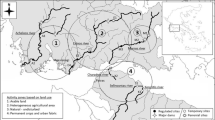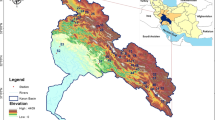Abstract
In the EU water framework directive (WFD) a typological framework is defined for assessing the ecological quality of water bodies in the future. The aim of this study was to test the effect of data composition and taxonomic resolution on this typology. The EU research projects AQEM and STAR provided 1660 samples of 48 stream types sampled all over the major geographical gradients in Europe. These stream types fit the WFD typological demands and fit to the major European geographic regions (ecoregions). The samples included gradients from reference conditions to samples with bad ecological quality. Despite standardisation, there were large differences between the participating countries concerning the number of taxa, the number of specimens, and the taxonomic resolution. The macroinvertebrate data were analysed by using detrended correspondence analysis (DCA). The distribution patterns using all samples, only reference samples, and only degraded samples showed that the use of species-level (or ‘best available taxonomic’ level) performed better at a practical (fine) scale in comparison to family-level. The analyses further showed that even the use of a standardised protocol can not easily overcome (i) differences in site conditions that force the researcher to deviate from the protocol as well as (ii) the experiences of the researcher(s) and (iii) the available taxonomic knowledge.
Similar content being viewed by others
References
Davies, P. E., 2000. Development of a national river bioassessment system, AUSRIVAS in Australia. In Wright, J. F., D. W. Sutcliffe & M. T. Furse (eds), Assessing the Biological Quality of Fresh Waters – RIVPACS and Other Techniques. Freshwater Biology, 113–124
European Commission, 2000. Directive 2000/60/EC. Establishing a framework for community action in the field of water policy. European Commission PE-CONS 3639/1/100 Rev 1, Luxembourg
C. A. Frissell W. J. Liss C. E. Warren M. D. Hurley (1986) ArticleTitleA hierarchical approach to classifying stream habitat features: viewing streams in a watershed context Environmental Management 10 199–214 Occurrence Handle10.1007/BF01867358
Furse, M. T., A. Schmidt-Kloiber, J. Strackbein, J. Davy-Bowker, A. Lorenz, J. van der Molen & P. Scarlett, 2004. Standardisation of river classifications. Results of the sampling programme. European 5th Framework Porgramme, research project STAR, 6th Deliverable, 31/07/04, 130
Furse, M., D. Hering, O. Moog, P. Verdonschot, R. K. Johnson, K. Brabec, K. Gritzalis, A. Buffagni, P. Pinto, N. Friberg, J. Murray-Bligh, J. Kokes, R. Alber, P. Usseglio-Polatera, P. Haase, R. Sweeting, B. Bis, K. Szoszkiewicz, H. Soszka, G. Springe, F. Sporka & I. Krno, 2006. The STAR project: context, objectives and approaches. Hydrobiologia 566: 3–29
D. Hering O. Moog L. Sandin P. F. M. Verdonschot (2004) ArticleTitleOverview and application of the AQEM assessment system Hydrobiologia 516 1–20 Occurrence Handle10.1023/B:HYDR.0000025255.70009.a5
J. R. Karr E. W. Chu (1999) Restoring Life in Running Waters: Better Biological Monitoring Island Press Washington, DC
D. R. Lenat V. H. Resh (2001) ArticleTitleTaxonomy and stream ecology – the benefits of genus- and species-level identifications Journal of the North American Benthological Society 20 287–298 Occurrence Handle10.2307/1468323
O. Moog (1995) Fauna Aquatica Austriaca. A Comprehensive Species Inventory of Austrian Aquatic Organisms with Ecological Notes Federal Ministry for Agriculture and Forestry Wasserwirtschaftskataster Vienna
O. Moog E. Bauernfeind P. Weichselbaumer (1997) The use of Ephemeroptera as saprobic indicators in Austria P. Landolt M. Sartori (Eds) Ephemeroptera & Plecoptera Biology- Ecology-Systematics Fribourg 254–260
O. Moog A. Schmidt-Kloiber T. Ofenböck J. Gerritsen (2004) ArticleTitleDoes the ecoregion approach support the typological demands of the EU “Water Framework Directive”? Hydrobiologia 516 21–33 Occurrence Handle10.1023/B:HYDR.0000025256.73580.3e
R. C. Nijboer A. Schmidt-Kloiber (2004) ArticleTitleThe effect of excluding rare taxa on the ecological quality assessment of running waters Hydrobiologia 516 347–363 Occurrence Handle10.1023/B:HYDR.0000025275.49062.55
R. C. Nijboer P. F. M. Verdonschot (2000) ArticleTitleTaxonomic adjustment affects data analysis: an often forgotten error Verhandlungen Internationale Verein für Limnology 27 1–4
F. W. Preston (1962) ArticleTitleThe canonical distribution of commonness and rarity: part 1 Ecology 43 185–215 Occurrence Handle10.2307/1931976
V. H. Resh E. P. McElravy (1993) Contemporary quantitative approaches to biomonitoring using benthic macroinvertebrates D. M. Rosenberg V. H. Resh (Eds) Freshwater Biomonitoring and Benthic Macroinvertebrates Chapman & Hall New York 159–194
V. H. Resh J. D. Unzicker (1975) ArticleTitleWater quality monitoring and aquatic organisms: the importance of species identification Journal of Water Pollution Federation 47 9–19 Occurrence Handle1:STN:280:CSqC3srns1I%3D
A. Schmidt-Kloiber R. C. Nijboer (2004) ArticleTitleThe effect of taxonomic resolution on the assessment of ecological water quality classes Hydrobiologia 516 269–283 Occurrence Handle10.1023/B:HYDR.0000025270.10807.10
I. Stubauer O. Moog (2000) ArticleTitleTaxonomic sufficiency versus need for information – comments on Austrian experience in biological water quality monitoring Verhandlungen Internationale Verein für Limnology 27 2562–2566
C. J. F. ter Braak P. Ŝmilauer (2002) CANOCO Reference Manual and Users Guide to Canoco for Windows. Software for Canonical Community Ordination (version 4.5) Centre for Biometry Wageningen, The Netherlands
InstitutionalAuthorNameUSEPA (U.S. Environmental Protection Agency) (1996) Biological Criteria: Technical Guidance for Streams and Small Rivers U.S. Environmental Protection Agency, Office of Water Washington, DC
Verdonschot, P. F. M., 1990. Ecological characterization of surface waters in the province of Overijssel (The Netherlands). Thesis, Agricultural University Wageningen, 255
Verdonschot, P. F. M., 2000. Integrated ecological assessment methods as a basis for sustainable catchment management. In Jungwirth, M., S. Muhar & S. Schmutz (eds), Assessing the Ecological Integrity of Running Waters. Proc. Int. Conf., Vienna, Austria. Developments in Hydrobiology 149. Hydrobiologia 422/423: 389–412
P. F. M. Verdonschot (2006) ArticleTitleEvaluation of the use of Water Framework Directive typology descriptors, reference sites, and spatial scale in macroinvertebrate stream typology Hydrobiologia 566 39–58
P. F. M. Verdonschot R. C. Nijboer (2004) ArticleTitleTesting the European stream typology of the water Framework Directive for macroinvertebrates Hydrobiologia 175 35–54 Occurrence Handle10.1023/B:HYDR.0000025257.30311.b7
H. Vlek P. F. M. Verdonschot R. C. Nijboer (2004) ArticleTitleTowards a multimetric index for the assessment of Dutch streams using benthic macroinvertebrates Hydrobiologia 516 173–189 Occurrence Handle10.1023/B:HYDR.0000025265.36836.e1
J. F. Wright D. Moss P. D. Armitage M. T. Furse (1984) ArticleTitleA preliminary classification of running-water sites in Great Britain based on macroinvertebrate species and the prediction of community type using environmental data Freshwater Biology 14 221–256 Occurrence Handle10.1111/j.1365-2427.1984.tb00039.x
Wright, J. F., D. W. Sutcliffe & M. T. Furse (eds), 1999. Assessing the biological quality of fresh waters: RIVPACS and other techniques. Freshwater Biological Association, Ambleside, Cumbria, UK. The RIVPACS International Workshop, 16–18 September 1997, Oxford, UK
Author information
Authors and Affiliations
Corresponding author
Rights and permissions
About this article
Cite this article
Verdonschot, P.F.M. Data composition and taxonomic resolution in macroinvertebrate stream typology. Hydrobiologia 566, 59–74 (2006). https://doi.org/10.1007/s10750-006-0070-y
Issue Date:
DOI: https://doi.org/10.1007/s10750-006-0070-y




